Gómez Manrique facts for kids
Gómez Manrique y de Castilla (born around 1412 – died around 1490) was a famous Spanish poet, a brave soldier, a smart politician, and a writer of plays. He lived during an important time in Spanish history.
Contents
The Life of Gómez Manrique
Gómez Manrique was born in a place called Amusco. He was the fifth son of Pedro Manrique de Lara y Mendoza, who was an important leader in Leon. From a young age, Gómez Manrique became involved in public life and politics.
He played a big part in the politics of his time. He was against some powerful figures, like Alvaro de Luna, during the rule of John II of Castile. Later, he also opposed Miguel Lucas de Iranzo when Henry IV of Castile was king. Gómez Manrique strongly supported Princess Isabel, who later became Queen Isabel I of Castile. He even helped arrange her marriage to Ferdinand of Aragon, who became King Ferdinand II of Aragon.
His Role as a Leader
Besides being a skilled soldier, Gómez Manrique was known for bringing peace and balance to political situations. He was appointed as a corregidor (a type of local governor) in Toledo. In this role, he worked hard to protect people who had converted to Judaism from unfair treatment by others. This shows he was a fair and just leader.
His Final Years
Gómez Manrique signed his will on May 31, 1490. We know for sure that he passed away before February 16, 1491.
Gómez Manrique's Writings
Gómez Manrique loved literature, just like his uncle, Iñigo López de Mendoza. People in his time thought he was a very talented writer. However, his fame was later overshadowed by his nephew, Jorge Manrique, who died in 1478. Jorge Manrique's poem, Coplas por la muerte de su padre (Verses on the Death of His Father), became much more famous.
Discovering His Poems
Gómez Manrique's own poems were not printed until 1885. This was when a person named Antonio Paz y Melia collected and published them. Once his poems were available, people quickly realized he was a very good poet. It is believed that his poem, Consejos (Advice), which he wrote for Diego Arias de Avila, actually inspired his nephew Jorge's more famous Coplas.
Gómez Manrique's teaching poems were similar to those written by his uncle, the Marquis of Santillana. He also wrote a play called Representación del nascimiento de Nuestro Senor, which was about the Passion of Christ. He also created two momos, which were short plays or interludes performed at court, along with many other poems.
See also
 In Spanish: Gómez Manrique (poeta) para niños
In Spanish: Gómez Manrique (poeta) para niños


